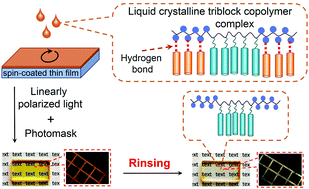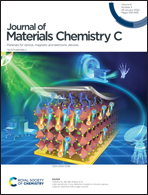Azobenzene-containing liquid crystalline block copolymer supramolecular complexes as a platform for photopatternable colorless materials†
Abstract
Supramolecular self-assembly of a host polymer with small guest molecules is a versatile and efficient approach for designing various stimuli-responsive polymer materials among which are liquid crystalline (LC) polymers. This work reports the synthesis and investigation of photosensitive side-chain liquid crystalline triblock copolymer supramolecular complexes formed via intermolecular pyridine–phenol hydrogen bonding. These complexes are based on ABA host triblock copolymers with phenyl benzoate mesogenic groups and 4-vinylpyridine units and an azobenzene-containing phenol, which play the role of small guest molecules. We demonstrate that irradiation of complex films with linearly polarized light and subsequent rinsing with diethyl ether result in colorless birefringent films with recorded phase images. It is shown that the morphology of the triblock copolymer complexes influences the kinetics of the photoorientation as well as the rinsing process. For the films of a random copolymer complex, the rinsing process leads to erasing recorded images, that is, a microphase separated structure is crucial for optical recording.

- This article is part of the themed collection: Journal of Materials Chemistry C HOT Papers


 Please wait while we load your content...
Please wait while we load your content...